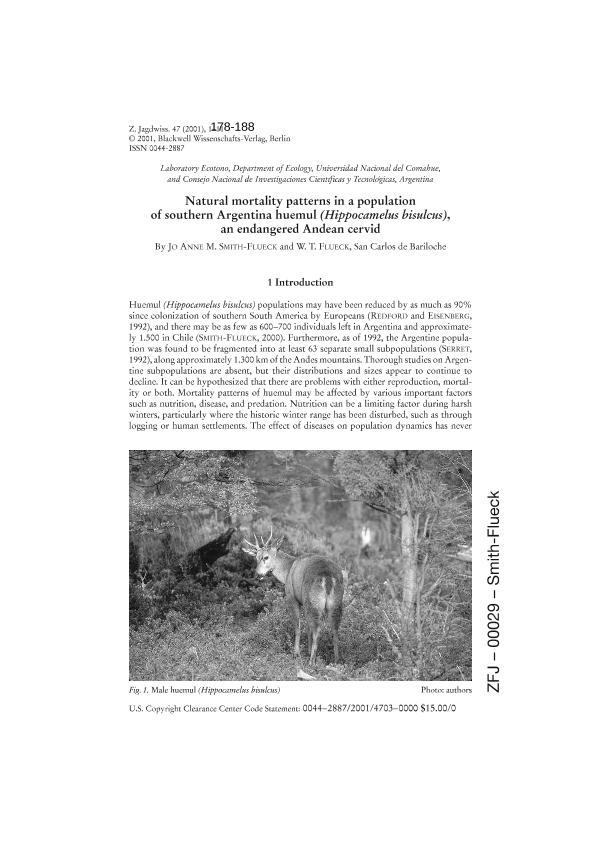Mostrar el registro sencillo del ítem
dc.contributor.author
Smith Fluck, Anne M.
dc.contributor.author
Fluck, Werner Thomas

dc.date.available
2018-03-27T13:59:14Z
dc.date.issued
2001-12
dc.identifier.citation
Smith Fluck, Anne M.; Fluck, Werner Thomas; Natural mortality patterns in a population of southern Argentina huemul (Hippocamelus bisulcus), an endangered Andean cervid; Blackwell Verlag GmbH Berlin; Zeitschrift fur Jagdwissenschaft; 47; 3; 12-2001; 178-188
dc.identifier.issn
0044-2887
dc.identifier.uri
http://hdl.handle.net/11336/40114
dc.description.abstract
The huemul (Hippocamelus bisulcus), an endangered deer living in the Andes of southern South America, numbers 600-700 in Argentina, from at least 63 fragmented subpopulations. Very limited information exists on most populations, but there are indications that the distribution and population sizes continue to diminish, possibly through reduced reproductive rates, elevated mortality rates or both. This is the first analysis of the population ecology of a subpopulation in Argentina, made possible through the only existing compilation of numerous remains of dead huemul (n = 19). Surveys were conducted between 1993 and 1999 to locate and collect remains, which were found concentrated at lower elevations. The sex ratio of adults and subadults (n = 12) was 1:1, but could not be determined for fawns. Clear signs of predation was found in 37% of all deer: 50% among calves, 50% among subadults and 31% among adults. These signs occurred in 29% of adult females and 50% of adult males. Deaths occurred during winter as judged by the state of the male skulls, which indicated the phase of the antler cycle. Femur fat content of 3 deer averaged 93%. Predation signs frequently were clearly from puma (Puma concolor), which is the only natural predator of huemul. The high predation rate, high marrow fat content and no indications of deaths resulting from disease corroborate the pristine state of the of mature lenga (Nothofagus pumilio) forest. The area with a concentration of huemul carcasses appears to be the huemul's major winter habitat.
dc.format
application/pdf
dc.language.iso
eng
dc.publisher
Blackwell Verlag GmbH Berlin
dc.rights
info:eu-repo/semantics/openAccess
dc.rights.uri
https://creativecommons.org/licenses/by-nc-sa/2.5/ar/
dc.subject
Habitat
dc.subject
Hippocamelus Bisulcus
dc.subject
Huemul
dc.subject
Mortality Pattern
dc.subject
Population Dynamics
dc.subject
Puma Concolor
dc.subject.classification
Otras Ciencias Biológicas

dc.subject.classification
Ciencias Biológicas

dc.subject.classification
CIENCIAS NATURALES Y EXACTAS

dc.title
Natural mortality patterns in a population of southern Argentina huemul (Hippocamelus bisulcus), an endangered Andean cervid
dc.type
info:eu-repo/semantics/article
dc.type
info:ar-repo/semantics/artículo
dc.type
info:eu-repo/semantics/publishedVersion
dc.date.updated
2018-03-16T14:30:02Z
dc.journal.volume
47
dc.journal.number
3
dc.journal.pagination
178-188
dc.journal.pais
Alemania

dc.journal.ciudad
Hamburg
dc.description.fil
Fil: Smith Fluck, Anne M.. Consejo Nacional de Investigaciones Científicas y Técnicas; Argentina. Universidad Nacional del Comahue. Centro Regional Universitario Bariloche. Departamento de Ecología; Argentina
dc.description.fil
Fil: Fluck, Werner Thomas. Consejo Nacional de Investigaciones Científicas y Técnicas; Argentina. Universidad Nacional del Comahue. Centro Regional Universitario Bariloche. Departamento de Ecología; Argentina
dc.journal.title
Zeitschrift fur Jagdwissenschaft
dc.relation.alternativeid
info:eu-repo/semantics/altIdentifier/doi/http://dx.doi.org/10.1007/BF02241548
dc.relation.alternativeid
info:eu-repo/semantics/altIdentifier/url/https://link.springer.com/article/10.1007%2FBF02241548
Archivos asociados
